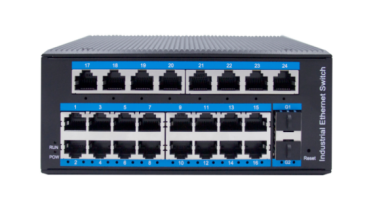.

As an important network device in the field of industrial automation, industrial switches play a key role in connecting and managing various industrial devices. It not only needs to have high reliability and stability, but also needs to meet the special needs of the industrial environment. This article will decipher the key functions and technologies of industrial switches to help readers better understand and apply this important device.

1. High reliability and stability
Industrial switches need to have high reliability and stability in the industrial environment to ensure reliable data transmission and stable operation of equipment. To this end, industrial switches adopt a variety of technologies to improve their reliability, such as redundant power supply, redundant links, ring network recovery time, etc. In addition, industrial switches also have anti-interference capabilities, which can cope with electromagnetic interference, temperature changes and other factors in the industrial environment.
2. Network Management and Security
Industrial switches have powerful network management and security functions, which can monitor, configure and manage the network. It supports VLAN, QoS, IGMP Snooping and other functions, which can realize the control and optimization of network traffic. In addition, industrial switches also support network security functions, such as port security, access control list, MAC address filtering, etc., to protect the security of industrial networks.
3. Industrial protocol support
Industrial switches need to support various industrial protocols to meet the communication needs of different industrial devices. Common industrial protocols include Modbus, PROFINET, EtherNet/IP, etc. By supporting these protocols, industrial switches can realize data exchange and communication between industrial devices.
4. Environmental adaptability
Industrial switches need to adapt to harsh industrial environments, such as high temperature, low temperature, humidity, dust, etc. Therefore, industrial switches are usually dustproof, waterproof, and corrosion-resistant to ensure their normal operation in harsh environments.
5. Remote management and monitoring
Industrial switches support remote management and monitoring, and can remotely configure and manage switches through the network. This is especially important for distributed industrial networks, which can reduce manual intervention and maintenance costs, and improve network reliability and efficiency.

6. Timing Accuracy
In some industrial applications, timing accuracy is critical. By supporting technologies such as IEEE 1588 Precision Time Protocol (PTP), industrial switches can realize the clock synchronization of each device in the network and ensure the timing accuracy of data.
7. Scalability and flexibility
Industrial switches need to have good scalability and flexibility to cope with changing industrial network requirements. It usually supports modular design and can be expanded and upgraded according to actual needs. In addition, industrial switches also support a variety of network connection methods, such as optical fiber, copper cable, etc., to adapt to different network environments.
8. Energy Efficiency
Industrial switches are also considered in terms of energy saving and energy efficiency. It usually uses low-power chips and designs to reduce energy consumption. In addition, industrial switches also support energy-saving functions, such as port sleep, automatic power adjustment, etc., to further improve energy efficiency.
As a key network device in the field of industrial automation, industrial switches have high reliability, stability, network management and security, industrial protocol support, environmental adaptability, remote management and monitoring, timing accuracy, scalability and flexibility, and energy Key functions and technologies such as efficiency. It plays a vital role in industrial networks and drives the development and progress of industrial automation.





